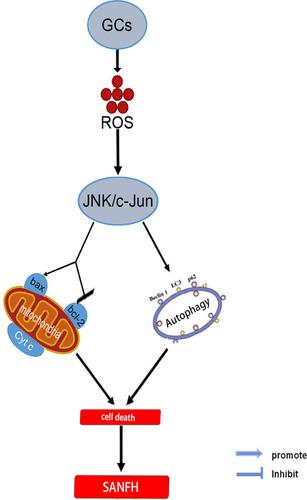当前位置:
X-MOL 学术
›
FEBS Open Bio
›
论文详情
Our official English website, www.x-mol.net, welcomes your feedback! (Note: you will need to create a separate account there.)
Glucocorticoids induce femoral head necrosis in rats through the ROS/JNK/c‐Jun pathway
FEBS Open Bio ( IF 2.6 ) Pub Date : 2020-11-15 , DOI: 10.1002/2211-5463.13037 Puji Peng 1 , Zhigang Nie 1 , Fei Sun 1 , Hao Peng 1
FEBS Open Bio ( IF 2.6 ) Pub Date : 2020-11-15 , DOI: 10.1002/2211-5463.13037 Puji Peng 1 , Zhigang Nie 1 , Fei Sun 1 , Hao Peng 1
Affiliation

|
Osteonecrosis of the femoral head (ONFH) is a common clinical disease with a high disability rate. Apoptosis of osteoblasts caused by high‐dose short‐term or low‐dose long‐term glucocorticoid (GC) administration is the biological basis of steroid‐induced avascular necrosis of the femoral head (SANFH). The pathogenesis of SANFH has not yet been fully elucidated, and there is currently a lack of effective clinical treatments. Here, we investigated the role of the reactive oxygen species (ROS)/JNK/c‐Jun signaling pathway in SANFH. Dexamethasone (Dex) was used to induce apoptosis in osteoblasts, and this resulted in a significant increase in levels of p‐JNK, p‐c‐Jun, Bax, caspase‐3, caspase‐9, cytochrome C, Beclin‐1, and LC3, and a decrease in levels of P62 and Bcl‐2. In addition, intracellular ROS levels were increased and mitochondrial membrane potential was decreased. Administration of 3‐MA, an autophagy inhibitor, attenuated Dex‐mediated changes in autophagy and apoptosis. A rat model of ONFH exhibited severe bone trabecular hollow bone pits along with a significant increase in femoral head cell apoptosis compared with the control group. Additionally, micro‐CT analysis showed that both bone tissue content and femoral head integrity were significantly reduced in the ONFH group. Furthermore, 3‐MA treatment decreased the effect of Dex on GC‐induced ONFH and osteoblast apoptosis in rats and could counteract microstructure destruction due to femoral head necrosis. In summary, our data suggest that GC can induce osteoblast apoptosis and autophagy through the ROS/JNK/c‐Jun signaling pathway, which contributes to ONFH.
中文翻译:

糖皮质激素通过 ROS/JNK/c-Jun 通路诱导大鼠股骨头坏死
股骨头坏死(ONFH)是临床常见病,致残率高。高剂量短期或低剂量长期糖皮质激素(GC)给药引起的成骨细胞凋亡是类固醇诱导的股骨头缺血性坏死(SANFH)的生物学基础。SANFH的发病机制尚未完全阐明,目前缺乏有效的临床治疗方法。在这里,我们研究了活性氧 (ROS)/JNK/c-Jun 信号通路在 SANFH 中的作用。地塞米松 (Dex) 用于诱导成骨细胞凋亡,这导致 p-JNK、p-c-Jun、Bax、caspase-3、caspase-9、细胞色素 C、Beclin-1 和LC3,以及 P62 和 Bcl-2 水平的降低。此外,细胞内 ROS 水平升高,线粒体膜电位降低。给予自噬抑制剂 3-MA 可减弱 Dex 介导的自噬和细胞凋亡变化。与对照组相比,ONFH大鼠模型表现出严重的骨小梁空心骨凹坑以及股骨头细胞凋亡显着增加。此外,显微 CT 分析显示,ONFH 组的骨组织含量和股骨头完整性均显着降低。此外,3-MA 治疗降低了 Dex 对 GC 诱导的大鼠 ONFH 和成骨细胞凋亡的影响,并可以抵消股骨头坏死引起的微结构破坏。总之,我们的数据表明,GC 可以通过 ROS/JNK/c-Jun 信号通路诱导成骨细胞凋亡和自噬,这有助于 ONFH。
更新日期:2021-01-04
中文翻译:

糖皮质激素通过 ROS/JNK/c-Jun 通路诱导大鼠股骨头坏死
股骨头坏死(ONFH)是临床常见病,致残率高。高剂量短期或低剂量长期糖皮质激素(GC)给药引起的成骨细胞凋亡是类固醇诱导的股骨头缺血性坏死(SANFH)的生物学基础。SANFH的发病机制尚未完全阐明,目前缺乏有效的临床治疗方法。在这里,我们研究了活性氧 (ROS)/JNK/c-Jun 信号通路在 SANFH 中的作用。地塞米松 (Dex) 用于诱导成骨细胞凋亡,这导致 p-JNK、p-c-Jun、Bax、caspase-3、caspase-9、细胞色素 C、Beclin-1 和LC3,以及 P62 和 Bcl-2 水平的降低。此外,细胞内 ROS 水平升高,线粒体膜电位降低。给予自噬抑制剂 3-MA 可减弱 Dex 介导的自噬和细胞凋亡变化。与对照组相比,ONFH大鼠模型表现出严重的骨小梁空心骨凹坑以及股骨头细胞凋亡显着增加。此外,显微 CT 分析显示,ONFH 组的骨组织含量和股骨头完整性均显着降低。此外,3-MA 治疗降低了 Dex 对 GC 诱导的大鼠 ONFH 和成骨细胞凋亡的影响,并可以抵消股骨头坏死引起的微结构破坏。总之,我们的数据表明,GC 可以通过 ROS/JNK/c-Jun 信号通路诱导成骨细胞凋亡和自噬,这有助于 ONFH。


























 京公网安备 11010802027423号
京公网安备 11010802027423号